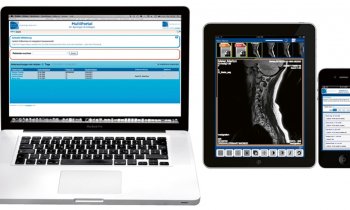Article • IoT, 5G and more
Securing mobile working in healthcare
Dramatic developments in digital technologies have fuelled the growth and need for a mobile workforce, with the number of mobile workers predicted to climb to 1.87 billion by 2022 – accounting for almost half (42.5%) of the global workforce.
By Nick Offin

The healthcare industry is no exception to this. In fact, the global healthcare mobility solutions market is predicted to experience a 25% year on year growth over the next few years and will be worth over £81 million by 2025. The majority of organisations have a mobility strategy in place with this in mind, yet the fast-paced nature of technology innovation, and rapid data explosion driven by the Internet of Things (IoT) and 5G means that such strategies need to be constantly revised and updated to meet the latest demands and the data security challenges that come with a mobile workforce.
Mobile working to boost patient care
For the healthcare industry, mobile working isn’t a new phenomenon. The sector has employed remote workers since before the days of devices and apps, however, recent advances in technology have enabled better patient care outside of traditional medical facilities.
Increased adoption of mobile working devices has enabled better access to patient information, which ultimately leads to improved workflows and a higher standard of care. The National Mobile Worker Project report found that with the community carers group who work remotely, productivity levels increased by 40 per cent.
Mobile working is having a significant impact in changing the relationship between healthcare provider and patient – and technology developments driven by the IoT are driving digital transformations which provide better customer services and ultimately better care.
Recommended article

Article • Mobile data transfer
5G makes tele-surgery fit for the future
A 4G symbol next to the signal strength bar on a smartphone assures fast data transmission. 5G, the next generation of technology, is already waiting in the wings and could herald a new era for tele-surgery, PD Dr. Michael Kranzfelder is convinced. However, there are a few obstacles to overcome first.
Futureproofing mobile working
While IT decision-makers in healthcare continue to recognise the benefits of mobile working, it’s critical to understand the risks that accompany these advantages. The healthcare industry is a significant producer of data, whether that be medical notes and images, insurance claims, or more recently information from wearables and IoT monitoring devices.
This ever-multiplying amount of high-value information creates greater opportunities for cyber criminals to target healthcare organisations, with the average cost of cyberattacks on healthcare organisations £9.26 million.
Healthcare organisations can look to mitigate the data security challenges mobile working presents through device and employee investment. According to a recent reader poll from Health Business conducted for Dynabook, just 18 per cent of healthcare professionals said their organisation offers data security training but believe more could be done, while 12 per cent stated that the take-up of training is poor and not compulsory.
With cyber-attacks on all industries growing more than 350% annually, it’s imperative training becomes a greater priority. However, education can only play one small part. Securing the mobile workforce means getting security right at a device-level and equipping workers in the field with robust devices that can protect them against potential cyber risks.
For example, devices which have advanced biometric features and hardware-based credential storage capabilities enhances protection against password or access hacking, while Mobile Zero Clients eliminate the device level-threat by removing data from the devices themselves and instead storing it centrally.
Recommended article

Article • WannaCry
NHS remains vulnerable to cyberattack
The global WannaCry ransomware cyberattack had a particularly acute impact on health services across the UK. Mark Nicholls looks at how the NHS was left vulnerable to the WannaCry cyberattack. While affecting computers across the world – from Russia to the US – NHS hospitals were forced to cancel routine surgery and GP appointments as systems were affected by the cyberattack or were…
Eliminating the device-level threat
With technologies such as 5G and IoT set to hit the mainstream next year, these security challenges will only grow
Mobile working creates a much wider network of device infrastructure to be managed, solutions such as Mobile Zero Clients help to protect against unsolicited access and data loss wherever a device is. Such tools help to nullify the device-level threat by withdrawing data from the device itself when not in use. By placing data under central storage and management rather than at a device-level, it is protected in the event of loss or theft and remains accessible in the most secure way possible.
Healthcare workers can view data in real-time even when visiting patients in secondary locations, be that via home visits or at other medical facilities and be confident that this data is safe when they have finished with a patient.
Solutions like these, which can future-proof the IT infrastructure at a time when everything around it is moving at breakneck speed, can prove invaluable to a 2020 mobility strategy. With technologies such as 5G and IoT set to hit the mainstream next year, these security challenges will only grow. As such, balancing mobility and security for all organisations is imperative. Decision makers must ensure that the right strategies are in place to ensure security, productivity and mobility.
06.12.2019











